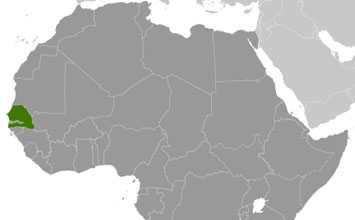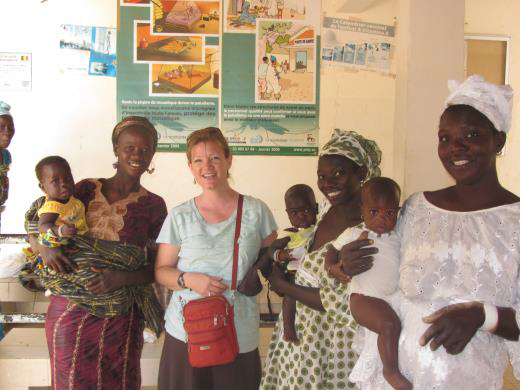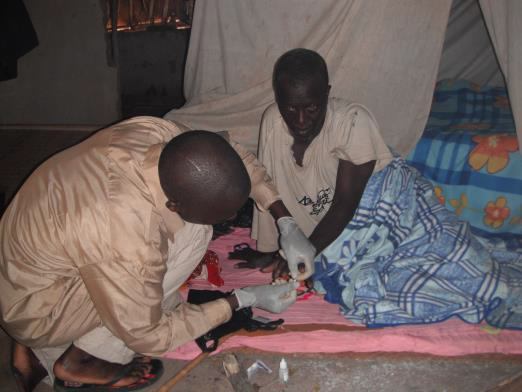
CDC has provided assistance for HIV/AIDS in Senegal since 2001, starting with the “Leadership and Investment in Fighting an Epidemic” Initiative. CDC currently focuses on strengthening HIV strategic information. In 2006, CDC began collaborating with the government on the launch of the U.S. President’s Malaria Initiative.
Download PDF Version
 Staff
Staff
CDC office (physical presence)
1 U.S. Assignees
No Locally Employed
 Senegal at a Glance
Senegal at a Glance
Population: 13,108,000
Per capita income: $1,810
Life expectancy at birth women/men: 61/59 yrs
Infant mortality rate: 51/1000 live births
Population Reference Bureau World Population Data Sheet, 2011
 Top 10 Causes of Death
Top 10 Causes of Death
Source: GBD Compare, 2013
- Stroke 9%
- Lower Respiratory Infections 9%
- Malaria 9%
- HIV 8%
- Cancer 5%
- Ischemic Heart Disease 5%
- Sepsis 4%
- Protein-Energy Malnutrition 4%
- Preterm Birth Complications 3%
- Road Injuries 3%
- Page last reviewed: April 1, 2015
- Page last updated: April 1, 2015
- Content source:
Global Health
Notice: Linking to a non-federal site does not constitute an endorsement by HHS, CDC or any of its employees of the sponsors or the information and products presented on the site.



 ShareCompartir
ShareCompartir

 CDC-Senegal jointly manages the U.S. President’s Malaria Initiative (PMI) activities with USAID and works with the Ministry of Health and other partners to develop proven policies and programs that reduce the burden of malaria in Senegal and build in-country capacity. CDC and USAID staff in country work together to oversee all technical and administrative aspects of PMI in Senegal. CDC provides technical assistance for operations research, diagnostics, case management, malaria in pregnancy, malaria surveillance, program evaluation, and vector control. The CDC resident advisor provides valuable support for the design and implementation of continuous demographic and health surveys to monitor the burden of disease and impact of interventions. CDC also assists with research related to insecticide-treated net longevity and malaria case management at health facilities.
CDC-Senegal jointly manages the U.S. President’s Malaria Initiative (PMI) activities with USAID and works with the Ministry of Health and other partners to develop proven policies and programs that reduce the burden of malaria in Senegal and build in-country capacity. CDC and USAID staff in country work together to oversee all technical and administrative aspects of PMI in Senegal. CDC provides technical assistance for operations research, diagnostics, case management, malaria in pregnancy, malaria surveillance, program evaluation, and vector control. The CDC resident advisor provides valuable support for the design and implementation of continuous demographic and health surveys to monitor the burden of disease and impact of interventions. CDC also assists with research related to insecticide-treated net longevity and malaria case management at health facilities. The focus of CDC-supported polio eradication activities is to increase the immunity of the population through immunization campaigns, to strengthen surveillance, to prevent re-importation of wild poliovirus and to minimize the consequences of any further international spread of virus into West Africa. CDC has deployed 9 public health professionals to work in Senegal on immunization activities through the Stop the Transmission of Polio program since the program began in 1999. In 2009, CDC facilitated collaboration between WHO and U.S. Peace Corps-Senegal to encourage volunteers to participate in vaccine-preventable disease surveillance and other national immunization activities. CDC also co-founded the Measles & Rubella Initiative partnership that is working to eliminate measles and rubella in Senegal as well as in the other parts of the world. Senegal had 18 cases of wild polio virus in 2010 but has had no cases since then.
The focus of CDC-supported polio eradication activities is to increase the immunity of the population through immunization campaigns, to strengthen surveillance, to prevent re-importation of wild poliovirus and to minimize the consequences of any further international spread of virus into West Africa. CDC has deployed 9 public health professionals to work in Senegal on immunization activities through the Stop the Transmission of Polio program since the program began in 1999. In 2009, CDC facilitated collaboration between WHO and U.S. Peace Corps-Senegal to encourage volunteers to participate in vaccine-preventable disease surveillance and other national immunization activities. CDC also co-founded the Measles & Rubella Initiative partnership that is working to eliminate measles and rubella in Senegal as well as in the other parts of the world. Senegal had 18 cases of wild polio virus in 2010 but has had no cases since then. In addition to providing technical assistance to neglected tropical disease (NTD) programs in Senegal, CDC conducted operational research, supported by the Bill and Melinda Gates Foundation, to develop more cost-effective ways of implementing integrated NTD programs. The broader NTD community, including CDC, is focusing on developing strategies that capitalize on synergies among these programs, in order to rapidly expand. In three countries, including Senegal, CDC tested a method of mapping that incorporates several NTDs instead of just one. The effort proved highly successful – so much so that Sightsavers, a nongovernmental organization devoted to preventing and treating diseases of the eye, has requested that CDC implement this approach in three districts in Senegal.
In addition to providing technical assistance to neglected tropical disease (NTD) programs in Senegal, CDC conducted operational research, supported by the Bill and Melinda Gates Foundation, to develop more cost-effective ways of implementing integrated NTD programs. The broader NTD community, including CDC, is focusing on developing strategies that capitalize on synergies among these programs, in order to rapidly expand. In three countries, including Senegal, CDC tested a method of mapping that incorporates several NTDs instead of just one. The effort proved highly successful – so much so that Sightsavers, a nongovernmental organization devoted to preventing and treating diseases of the eye, has requested that CDC implement this approach in three districts in Senegal.